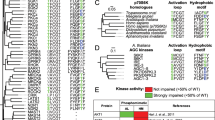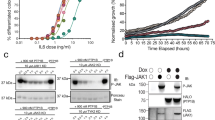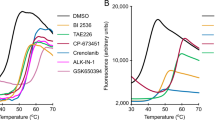Abstract
Protein phosphorylation transduces a large set of intracellular signals. One mechanism by which phosphorylation mediates signal transduction is by prompting conformational changes in the target protein or interacting proteins. Previous work described an allosteric site mediating phosphorylation-dependent activation of AGC kinases. The AGC kinase PDK1 is activated by the docking of a phosphorylated motif from substrates. Here we present the crystallography of PDK1 bound to a rationally developed low-molecular-weight activator and describe the conformational changes induced by small compounds in the crystal and in solution using a fluorescence-based assay and deuterium exchange experiments. Our results indicate that the binding of the compound produces local changes at the target site, the PIF binding pocket, and also allosteric changes at the ATP binding site and the activation loop. Altogether, we present molecular details of the allosteric changes induced by small compounds that trigger the activation of PDK1 through mimicry of phosphorylation-dependent conformational changes.
This is a preview of subscription content, access via your institution
Access options
Subscribe to this journal
Receive 12 print issues and online access
$259.00 per year
only $21.58 per issue
Buy this article
- Purchase on Springer Link
- Instant access to full article PDF
Prices may be subject to local taxes which are calculated during checkout



Similar content being viewed by others
References
Olsen, J.V. et al. Global, in vivo, and site-specific phosphorylation dynamics in signaling networks. Cell 127, 635–648 (2006).
Johnson, L.N. & Lewis, R.J. Structural basis for control by phosphorylation. Chem. Rev. 101, 2209–2242 (2001).
Pawson, T. & Scott, J.D. Protein phosphorylation in signaling–50 years and counting. Trends Biochem. Sci. 30, 286–290 (2005).
Huse, M. & Kuriyan, J. The conformational plasticity of protein kinases. Cell 109, 275–282 (2002).
Pearl, L.H. & Barford, D. Regulation of protein kinases in insulin, growth factor and Wnt signalling. Curr. Opin. Struct. Biol. 12, 761–767 (2002).
Biondi, R.M. & Nebreda, A.R. Signalling specificity of Ser/Thr protein kinases through docking-site-mediated interactions. Biochem. J. 372, 1–13 (2003).
Newton, A.C. Protein kinase C: structural and spatial regulation by phosphorylation, cofactors, and macromolecular interactions. Chem. Rev. 101, 2353–2364 (2001).
Biondi, R.M. et al. Identification of a pocket in the PDK1 kinase domain that interacts with PIF and the C-terminal residues of PKA. EMBO J. 19, 979–988 (2000).
Frodin, M., Jensen, C.J., Merienne, K. & Gammeltoft, S. A phosphoserine-regulated docking site in the protein kinase RSK2 that recruits and activates PDK1. EMBO J. 19, 2924–2934 (2000).
Yang, J. et al. Molecular mechanism for the regulation of protein kinase B/Akt by hydrophobic motif phosphorylation. Mol. Cell 9, 1227–1240 (2002).
Yang, J. et al. Crystal structure of an activated Akt/protein kinase B ternary complex with GSK3-peptide and AMP-PNP. Nat. Struct. Biol. 9, 940–944 (2002).
Frodin, M. et al. A phosphoserine/threonine-binding pocket in AGC kinases and PDK1 mediates activation by hydrophobic motif phosphorylation. EMBO J. 21, 5396–5407 (2002).
Bayliss, R., Sardon, T., Vernos, I. & Conti, E. Structural basis of Aurora-A activation by TPX2 at the mitotic spindle. Mol. Cell 12, 851–862 (2003).
Manning, G., Whyte, D.B., Martinez, R., Hunter, T. & Sudarsanam, S. The protein kinase complement of the human genome. Science 298, 1912–1934 (2002).
Newton, A.C. Regulation of the ABC kinases by phosphorylation: protein kinase C as a paradigm. Biochem. J. 370, 361–371 (2003).
Parker, P.J. & Parkinson, S.J. AGC protein kinase phosphorylation and protein kinase C. Biochem. Soc. Trans. 29, 860–863 (2001).
Hauge, C. et al. Mechanism for activation of the growth factor-activated AGC kinases by turn motif phosphorylation. EMBO J. 26, 2251–2261 (2007).
Biondi, R.M. et al. High resolution crystal structure of the human PDK1 catalytic domain defines the regulatory phosphopeptide docking site. EMBO J. 21, 4219–4228 (2002).
Biondi, R.M. Phosphoinositide-dependent protein kinase 1, a sensor of protein conformation. Trends Biochem. Sci. 29, 136–142 (2004).
Biondi, R.M., Kieloch, A., Currie, R.A., Deak, M. & Alessi, D.R. The PIF-binding pocket in PDK1 is essential for activation of S6K and SGK, but not PKB. EMBO J. 20, 4380–4390 (2001).
Collins, B.J., Deak, M., Arthur, J.S., Armit, L.J. & Alessi, D.R. In vivo role of the PIF-binding docking site of PDK1 defined by knock-in mutation. EMBO J. 22, 4202–4211 (2003).
Collins, B.J., Deak, M., Murray-Tait, V., Storey, K.G. & Alessi, D.R. In vivo role of the phosphate groove of PDK1 defined by knockin mutation. J. Cell Sci. 118, 5023–5034 (2005).
Knighton, D.R. et al. Crystal structure of the catalytic subunit of cyclic adenosine monophosphate-dependent protein kinase. Science 253, 407–414 (1991).
Huang, X. et al. Crystal structure of an inactive akt2 kinase domain. Structure 11, 21–30 (2003).
Smith, K.J. et al. The structure of MSK1 reveals a novel autoinhibitory conformation for a dual kinase protein. Structure 12, 1067–1077 (2004).
Jacobs, M. et al. The structure of dimeric ROCK I reveals the mechanism for ligand selectivity. J. Biol. Chem. 281, 260–268 (2006).
Zhao, B. et al. Crystal structure of the kinase domain of serum and glucocorticoid-regulated kinase 1 in complex with AMP PNP. Protein Sci. 16, 2761–2769 (2007).
Engel, M. et al. Allosteric activation of the protein kinase PDK1 with low molecular weight compounds. EMBO J. 25, 5469–5480 (2006).
Stroba, A. et al. 3,5-diphenylpent-2-enoic acids as allosteric activators of the protein kinase PDK1: structure-activity relationships and thermodynamic characterisation of binding as paradigms for PIF-binding pocket-targeting compounds. J. Med. Chem. 52, 4683–4693 (2009).
Filippakopoulos, P. et al. Structural coupling of SH2-kinase domains links Fes and Abl substrate recognition and kinase activation. Cell 134, 793–803 (2008).
Zhang, X., Gureasko, J., Shen, K., Cole, P.A. & Kuriyan, J. An allosteric mechanism for activation of the kinase domain of epidermal growth factor receptor. Cell 125, 1137–1149 (2006).
Kabsch, W. Automatic processing of rotation diffraction data from crystals of initially unknown symmetry and cell constants. J. Appl. Crystallogr. 26, 795–800 (1993).
Kabsch, W. Automatic-indexing of rotation diffraction patterns. J. Appl. Crystallogr. 21, 67–71 (1988).
Read, R.J. Pushing the boundaries of molecular replacement with maximum likelihood. Acta Crystallogr. D Biol. Crystallogr. 57, 1373–1382 (2001).
Murshudov, G.N., Vagin, A.A. & Dodson, E.J. Refinement of macromolecular structures by the maximum-likelihood method. Acta Crystallogr. D Biol. Crystallogr. 53, 240–255 (1997).
Emsley, P. & Cowtan, K. Coot: model-building tools for molecular graphics. Acta Crystallogr. D Biol. Crystallogr. 60, 2126–2132 (2004).
Perrakis, A., Morris, R. & Lamzin, V.S. Automated protein model building combined with iterative structure refinement. Nat. Struct. Biol. 6, 458–463 (1999).
Schaeffer, F. et al. Duplicated dockerin subdomains of Clostridium thermocellum endoglucanase CelD bind to a cohesin domain of the scaffolding protein CipA with distinct thermodynamic parameters and a negative cooperativity. Biochemistry 41, 2106–2114 (2002).
Acknowledgements
We acknowledge A. Haouz for help with the crystallization screening, F. Saul for crystallography advice, J. Imig for help setting up the conditions for the TNP-ATP assay and I. Adrian for excellent technical assistance. We give special thanks to R.W. Hartmann, R. Zimmermann and R. Bernhardt (University of Saarland), and to A. Scheidig (University of Kiel) for support for our research project. We acknowledge the financial support of the Europrofession Foundation (Saarbrücken, Germany), the Deutsche Krebshilfe (107875), Deutsche Forschungsgemeinschaft (BI 1044/2-2) and Bundesministerium für Bildung und Forschung (Go-Bio). We are grateful to N. Huntington for careful reading of the manuscript.
Author information
Authors and Affiliations
Contributions
A.S. synthesized compounds under the direction of M.E. H.Z. performed deuterium exchange experiments under the direction of D.H. and T.J.D.J. A.S. and V.H. performed the ITC experiments under the supervision of F.S. V.H. performed crystallography work under the supervision of P.M.A. S.Z. gave general advice. L.I., L.A.L.-G. and V.H. performed protein purifications for crystallography work. L.A.L.-G. and V.H. performed TNP-ATP assays, purified GST fusion proteins and performed other biochemical experiments. R.M.B. supervised the protein production, general molecular biology, TNP-ATP assays, all additional biochemical work and the overall research project. The manuscript was written by R.M.B. with the support of V.H., H.Z. and P.M.A.
Corresponding author
Supplementary information
Supplementary Text and Figures
Supplementary Methods and Supplementary Results (PDF 1273 kb)
Rights and permissions
About this article
Cite this article
Hindie, V., Stroba, A., Zhang, H. et al. Structure and allosteric effects of low-molecular-weight activators on the protein kinase PDK1. Nat Chem Biol 5, 758–764 (2009). https://doi.org/10.1038/nchembio.208
Received:
Accepted:
Published:
Issue Date:
DOI: https://doi.org/10.1038/nchembio.208
This article is cited by
-
Influenza A Virus (H1N1) Infection Induces Glycolysis to Facilitate Viral Replication
Virologica Sinica (2021)
-
Pharmacologic treatment with CPI-613 and PS48 decreases mitochondrial membrane potential and increases quantity of autolysosomes in porcine fibroblasts
Scientific Reports (2019)
-
Discovery of SBF1 as an allosteric inhibitor targeting the PIF-pocket of 3-phosphoinositide-dependent protein kinase-1
Journal of Molecular Modeling (2019)
-
A novel allosteric site in casein kinase 2α discovered using combining bioinformatics and biochemistry methods
Acta Pharmacologica Sinica (2017)
-
Insulin augments serotonin-induced contraction via activation of the IR/PI3K/PDK1 pathway in the rat carotid artery
Pflügers Archiv - European Journal of Physiology (2016)



